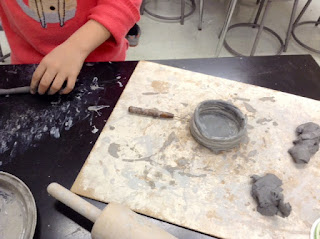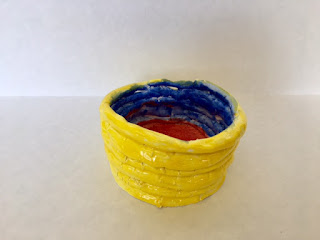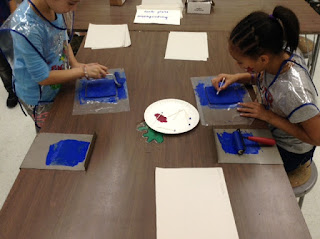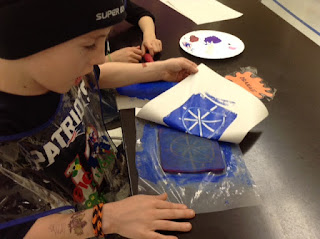Wednesday, May 31, 2017
Thursday, May 25, 2017
Clay Coil Pots
Recently, artists in 3rd grade made coil pots using clay. Clay comes from the Earth and is made up of different minerals. For thousands of years, people have been using clay to make pottery, making the clay into cups, bowls and vases to use. We learned that clay goes through many stages to become a finished, glazed coil pot and the first stage is wet clay.
 To begin, students used rolling pins to flatten the clay and used a yogurt cup to trace around and make the bottom of the coil pot. Then we took smaller pieces of clay and rolled them under our palms, forming coils or snake-like shapes. Students worked hard to create even coils that would reach all the way around their pot’s base.
To begin, students used rolling pins to flatten the clay and used a yogurt cup to trace around and make the bottom of the coil pot. Then we took smaller pieces of clay and rolled them under our palms, forming coils or snake-like shapes. Students worked hard to create even coils that would reach all the way around their pot’s base.
 We learned how to score, or scratch up, the clay and apply slip, which is a mixture of clay and water and acts as a glue, to attach our coils together. It is important to “scratch and attach” everything, because while it is wet, clay sticks together easily, but eventually it dries and can come apart.
We learned how to score, or scratch up, the clay and apply slip, which is a mixture of clay and water and acts as a glue, to attach our coils together. It is important to “scratch and attach” everything, because while it is wet, clay sticks together easily, but eventually it dries and can come apart.
 Students built coil pots using up to 6 layers of coils. The coil pots dried out for a week until they became bone dry and were fired in the kiln. The kiln is an oven for the clay to get heated and become hard.
The following class, students glazed their coil pots. Six color stations were set up around the room and students used the colors they wanted to use at that station.
Students built coil pots using up to 6 layers of coils. The coil pots dried out for a week until they became bone dry and were fired in the kiln. The kiln is an oven for the clay to get heated and become hard.
The following class, students glazed their coil pots. Six color stations were set up around the room and students used the colors they wanted to use at that station.
 Students had to carry their coil pots to the different stations very carefully! We painted 2-3 layers of glaze, so that the colors would come out bright. Students had to make sure to cover all the white spots, which was more challenging because of the texture of the fired clay. We also had to be patient to build the layers of glaze.
Students had to carry their coil pots to the different stations very carefully! We painted 2-3 layers of glaze, so that the colors would come out bright. Students had to make sure to cover all the white spots, which was more challenging because of the texture of the fired clay. We also had to be patient to build the layers of glaze.
 Some students chose to use solid colors and other students created patterns such as stripes or polka dots on the inside or outside of their coil pots. Students also had to make sure not to get glaze on the bottom of their coil pots, so that they would not stick to the kiln shelf during firing!
Some students chose to use solid colors and other students created patterns such as stripes or polka dots on the inside or outside of their coil pots. Students also had to make sure not to get glaze on the bottom of their coil pots, so that they would not stick to the kiln shelf during firing!
We got our coil pots back after they had been fired again, to melt the glaze onto our pot and make it shiny. Students noticed that the colors had gotten brighter! Below are some examples of our finished coil pots:
We got our coil pots back after they had been fired again, to melt the glaze onto our pot and make it shiny. Students noticed that the colors had gotten brighter! Below are some examples of our finished coil pots:
| Aysha, 3rd Grade (Fletcher Nickl) |
| Ben, 3rd Grade (Stone) |
 |
| Brixton, 3rd Grade (Stone) |
 |
| Edmond, 3rd Grade (Stone) |
 |
| Gavin, 3rd Grade (Fletcher Nickl) |
| Sam, 3rd Grade (Stone) |
 |
| Siobhan, 3rd Grade (Fletcher Nickl) |
| Valentina, 3rd Grade (Fletcher Nickl) |
 |
| Lory, 3rd Grade (Donato) |
 |
| Brenda, 3rd Grade (Donato) |
 |
| Gustavo, 3rd Grade (Donato) |
 |
| Edwin, 3rd Grade (Monfette) |
 |
| Emily, 3rd Grade (Monfette) |
 |
| Hunter, 3rd Grade (Lutz) |
 |
| Raffi, 3rd Grade (Monfette) |
 |
| Sophia S., 3rd Grade (Lutz) |
Thursday, May 18, 2017
Monoprinting Explorations with Gelli Plates
This spring, 3rd grade artists experimented with monoprinting using Gelli plates. Gelli plates look and feel a lot like gelatin, but are reusable (and not edible!). We learned that in monoprinting, you make a one of a kind print, unlike other forms of printmaking, where you can print the same image multiple times. We explored a few different monoprinting techniques, focusing on one technique per class.
 On the first class, we learned about the subtractive method of monoprinting. Students connected this technique to subtraction in math, which means to remove or take away. Students watched a demonstration before trying it themselves. First, we rolled acrylic paint on top of the Gelli plate in an even layer with a brayer. Using cotton swabs, we removed, or subtracted, some of the paint from the plate before placing a piece of paper on top and pulling the print. We used them because we cannot use anything sharp on the Gelli plate's surface.
Students experimented with different lines, shapes and symbols. We also noticed that everything we drew onto the plate came out backwards on the paper. The Gelli plates made monoprinting pretty easy!
On the first class, we learned about the subtractive method of monoprinting. Students connected this technique to subtraction in math, which means to remove or take away. Students watched a demonstration before trying it themselves. First, we rolled acrylic paint on top of the Gelli plate in an even layer with a brayer. Using cotton swabs, we removed, or subtracted, some of the paint from the plate before placing a piece of paper on top and pulling the print. We used them because we cannot use anything sharp on the Gelli plate's surface.
Students experimented with different lines, shapes and symbols. We also noticed that everything we drew onto the plate came out backwards on the paper. The Gelli plates made monoprinting pretty easy!
 After each print, we used the brayers to roll more paint on top of the plate and start again. Each student made 3 subtractive monoprints, sharing a Gelli plate and brayer with a partner. At the end of class, one student washed the brayer and the other partner cleaned the Gelli plate. The Gelli plates are easy to clean with a little hand sanitizer and paper towel.
After each print, we used the brayers to roll more paint on top of the plate and start again. Each student made 3 subtractive monoprints, sharing a Gelli plate and brayer with a partner. At the end of class, one student washed the brayer and the other partner cleaned the Gelli plate. The Gelli plates are easy to clean with a little hand sanitizer and paper towel.
 The following class, we learned about and experimented with the additive method of monoprinting. The opposite of the subtractive technique, we added the paint directly on top of the Gelli plate. Students used paintbrushes to paint lines, shapes and designs on top of the plate before placing a piece of paper on top and pulling the print. We used scrap newsprint paper to remove any remaining paint between prints. Each student made 3 additive monoprints and shared the clean up responsibilities at the end of class.
The following class, we learned about and experimented with the additive method of monoprinting. The opposite of the subtractive technique, we added the paint directly on top of the Gelli plate. Students used paintbrushes to paint lines, shapes and designs on top of the plate before placing a piece of paper on top and pulling the print. We used scrap newsprint paper to remove any remaining paint between prints. Each student made 3 additive monoprints and shared the clean up responsibilities at the end of class.
 The third technique we learned about was masking. Masking is when you cover up part of the plate with a material so that it masks that area. We used paper shapes to cover up parts of the Gelli plate.
We also experimented with layering as our fourth and final technique, printing on top of existing prints.
The third technique we learned about was masking. Masking is when you cover up part of the plate with a material so that it masks that area. We used paper shapes to cover up parts of the Gelli plate.
We also experimented with layering as our fourth and final technique, printing on top of existing prints.
 For this technique, we also had to register, or line up our prints, with the one already on the paper. This was challenging, but we noticed that layering our prints together created some very interesting effects and new color combinations.
For this technique, we also had to register, or line up our prints, with the one already on the paper. This was challenging, but we noticed that layering our prints together created some very interesting effects and new color combinations.
 After all of our monoprinting explorations, we looked at all of our prints and selected our three favorites to sign and title. Students had as many as 15 prints that they had made during all of our explorations! It was interesting to see prints we had made several classes ago. Students created a unique signature to sign all their prints and also spent time coming up with thoughtful and creative titles!
After all of our monoprinting explorations, we looked at all of our prints and selected our three favorites to sign and title. Students had as many as 15 prints that they had made during all of our explorations! It was interesting to see prints we had made several classes ago. Students created a unique signature to sign all their prints and also spent time coming up with thoughtful and creative titles!
 We finished with a gallery walk to see everyone's favorite three prints, spending time to notice the monoprinting technique(s) that were used and reading the titles. Our creative titles added a lot to our understanding of the prints.
We finished with a gallery walk to see everyone's favorite three prints, spending time to notice the monoprinting technique(s) that were used and reading the titles. Our creative titles added a lot to our understanding of the prints.
Below are some examples of our monoprints:
Below are some examples of our monoprints:
 |
| Aiden, 3rd Grade (Stone) |
 |
| Ally, 3rd Grade (Fletcher Nickl) |
| Andrew, 3rd Grade (Monfette) |
 |
| Ariana, 3rd Grade (Fletcher Nickl) |
 |
| Destanie, 3rd Grade (Monfette) |
 |
| Michelle, 3rd Grade (Stone) |
 |
| Pedro, 3rd Grade (Monfette) |
 |
| Priya, 3rd Grade (Monfette) |
 |
| Raffi, 3rd Grade (Monfette) |
| Sam, 3rd Grade (Stone) |
 |
| Sawyer, 3rd Grade (Fletcher Nickl) |
 |
| Tamia, 3rd Grade (Stone) |
| Wendy, 3rd Grade (Stone) |
 |
| Zarisha, 3rd Grade (Monfette) |
 |
| Alina, 3rd Grade (Lutz) |
 |
| Ethan, 3rd Grade (Donato) |
 |
| Evey, 3rd Grade (Lutz) |
 |
| Jimmy, 3rd Grade (Donato) |
 |
| Lamar, 3rd Grade (Lutz) |
 |
| Tatiana, 3rd Grade (Donato) |
Subscribe to:
Posts (Atom)


